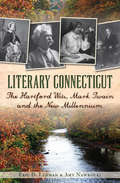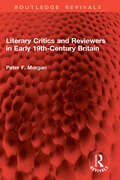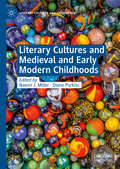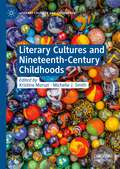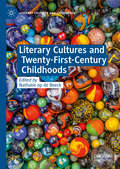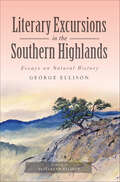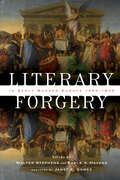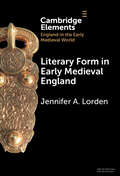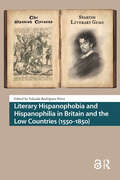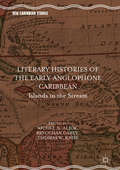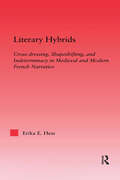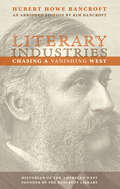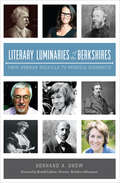- Table View
- List View
Literary Connecticut: The Hartford Wits, Mark Twain and the New Millennium
by Eric D. Lehman Amy NawrockiFrom the father of American English to the most famous novelist in America, Connecticut has produced and inspired a dazzling array of literary talent. Discover the secret passage to James Merrill's study in Stonington or navigate Hartford's Nook Farm neighborhood--a home and hub of inspiration to Harriet Beecher Stowe, Mark Twain and William Gillette. As an adult, Helen Keller's stomping grounds were the woods and gardens of Easton, while Eugene O'Neill's childhood home in New London found its way into the pages of his greatest work. These authors drove the same roads, frequented the same taverns and read the same books as the nutmeggers of today. Explore Connecticut's literary landscape with Eric D. Lehman and Amy Nawrocki as they introduce readers to some of the greatest writers who found a home in the Constitution State.
Literary Critics and Reviewers in Early 19th-Century Britain (Routledge Revivals)
by Peter F. MorganThe nineteenth century saw the growth of several major magazines devoted to the reviewing of contemporary literature. The new popular importance that literature was beginning to enjoy—in particular, the novel form—inevitably led to a change in the way literature was discussed and perceived.Three of the major reviews of the period that reflected this new outlook are discussed in Literary Critics and Reviewers in Early 19th-Century Britain (originally published in 1983)—the Whig Edinburgh Review, founded in 1804; the Quarterly Review, the government counterblast begun five years later; and the Westminster Review, the radical paper first instituted in 1824. Each of these received contributions from major writers themselves such as Carlyle, Macaulay, Scott, Southey, and Mill. These, together with Jeffrey, Lockhart, and Croker form the main subject of this book. By examining the work of each writer, the author conveys a sense of the richness and variety of the field.The criticism examined is important intrinsically, but also it is seen in the context of the philosophy and personality of the individual critic, and his important role, in the review especially, as mediating between literature and the reading public.
Literary Cultures and Medieval and Early Modern Childhoods (Literary Cultures and Childhoods)
by Naomi J. Miller Diane PurkissBuilding on recent critical work, this volume offers a comprehensive consideration of the nature and forms of medieval and early modern childhoods, viewed through literary cultures. Its five groups of thematic essays range across a spectrum of disciplines, periods, and locations, from cultural anthropology and folklore to performance studies and the history of science, and from Anglo-Saxon burial sites to colonial America. Contributors include several renowned writers for children. The opening group of essays, Educating Children, explores what is perhaps the most powerful social engine for the shaping of a child. Performing Childhood addresses children at work and the role of play in the development of social imitation and learning. Literatures of Childhood examines texts written for children that reveal alternative conceptions of parent/child relations. In Legacies of Childhood, expressions of grief at the loss of a child offer a window into the family’s conceptions and values. Finally, Fictionalizing Literary Cultures for Children considers the real, material child versus the fantasy of the child as a subject.
Literary Cultures and Nineteenth-Century Childhoods (Literary Cultures and Childhoods)
by Kristine Moruzi Michelle J. SmithLiterary Cultures and Nineteenth-Century Childhoods explores the construction of the child and the development of texts for children in the nineteenth century through the application of fresh theoretical approaches and attention to aspects of literary childhoods that have only recently begun to be illuminated. This scope enables examination of the child in canonical nineteenth-century novels by Charles Dickens, Elizabeth Gaskell, Charlotte Bronte, and Thomas Hardy alongside well-known fiction intended for young readers by George MacDonald, Christabel Coleridge, and Kate Greenaway. The century was also distinctive for the rise of the children’s magazine, and this book broadens the definition of literary cultures to include magazines produced both by, and for, young people. The volume examines how the child and family are conceptualised, how children are positioned as readers in genres including the domestic novel, school story, Robinsonade, and fantasy fiction, how literary childhoods are written and politicised, and how childhood intersects with perceptions of animals and the natural environment. The range of chapters in this collection and the texts they consider demonstrates the variability and fluidity of literary cultures and nineteenth-century childhoods.
Literary Cultures and Twenty-First-Century Childhoods (Literary Cultures and Childhoods)
by Nathalie op de BeeckIn the early decades of the twenty-first century, we are grappling with the legaciesof past centuries and their cascading effects upon children and all people. Werealize anew how imperialism, globalization, industrialization, and revolutioncontinue to reshape our world and that of new generations. At a volatile moment,this collection asks how twenty-first century literature and related mediarepresent and shape the contemporary child, childhood, and youth.Because literary representations construct ideal childhoods as well as model therights, privileges, and respect afforded to actual young people, this collectionsurveys examples from popular culture and from scholarly practice. Chaptersinvestigate the human rights of children in literature and international policy; thepotential subjective agency and power of the child; the role models proposed foryoung people; the diverse identities children embody and encounter; and theenvironmental well-being of future human and nonhuman generations.As a snapshot of our developing historical moment, this collection identifiesemergent trends, considers theories and critiques of childhood and literature,and observes how new technologies and paradigms are destabilizing pastconventions of storytelling and lived experience.
Literary Dollars and Social Sense: A People's History of the Mass Market Book
by Ronald J. Zboray Mary Saracino ZborayPrior to the Civil War, publishing in America underwent a transformation from a genteel artisan trade supported by civic patronage and religious groups to a thriving, cut-throat national industry propelled by profit. Literary Dollars and Social Sense represents an important chapter in the historical experience of print culture, it illuminates the phenomenon of amateur writing and delineates the access points of the emerging mass market for print for distributors consumers and writers. It challenges the conventional assumptions that the literary public had little trouble embracing the new literary marketing that emerged at mid-century. The book uncover the tensions that author's faced between literature's role in the traditional moral economy and the lure of literary dollars for personal gain and fame. This book marks an important example in how scholars understand and conduct research in American literature.
Literary Excursions in the Southern Highlands: Essays on Natural History (Natural History)
by George EllisonExtending from Roanoke to Mount Oglethorpe and bounded by the Appalachian Mountains, the Southern Highlands is one of the most diverse natural areas in North America. From beautiful flora like the Fraser magnolia to rare ecosystems such as the mountain cedar glades, the area has been an inspiration for writers and naturalists since it was first explored by William Bartram in 1775. Investigate the biology of the cloudless sulphur butterfly, whose erratic flight is used to confuse its prey. Discover the botany of the white ash tree, said to produce the most satisfying crack of a baseball bat. Essayist, poet and naturalist George Ellison explores the abundant wonders of the Southern Highlands in a series of humorous, scientific and literary essays vividly illustrated by artist Elizabeth Ellison.
Literary Executions: Capital Punishment and American Culture, 1820–1925
by John Cyril BartonExamines literary and legal sources to document thoughts and feelings about capital punishment in the United States over the long nineteenth century.Drawing from legal and extralegal discourse but focusing on imaginative literature, Literary Executions examines representations of, responses to, and arguments for and against the death penalty in the United States over the long nineteenth century. John Cyril Barton creates a generative dialogue between artistic relics and legal history. He looks to novels, short stories, poems, and creative nonfiction as well as legislative reports, trial transcripts, legal documents, newspaper and journal articles, treatises, and popular books (like The Record of Crimes, A Defence of Capital Punishment, and The Gallows, the Prison, and the Poor House), all of which were part of the debate over the death penalty.Barton focuses on several canonical figures—James Fenimore Cooper, Nathaniel Hawthorne, Lydia Maria Child, Walt Whitman, Herman Melville, and Theodore Dreiser—and offers new readings of their work in light of the death penalty controversy. Barton also gives close attention to a host of then-popular-but-now-forgotten writers—particularly John Neal, Slidell MacKenzie, William Gilmore Simms, Sylvester Judd, and George Lippard—whose work helped shape or was shaped by the influential anti-gallows movement. Analyzing the tension between sovereignty and social responsibility in a democratic republic, Barton argues that the high stakes of capital punishment dramatize the confrontation between the citizen-subject and sovereign authority in its starkest terms. In bringing together the social and the aesthetic, Barton shows how legal forms informed literary forms and traces the emergence of the modern State in terms of the administration of lawful death.By engaging the politics and poetics of capital punishment, Literary Executions contends that the movement to abolish the death penalty in the United States should be seen as an important part of the context that brought about the flowering of the American Renaissance during the antebellum period and that influenced literature later in the nineteenth and early twentieth centuries.
Literary Executions: Capital Punishment and American Culture, 1820–1925
by John Cyril Barton“Rich with historical detail . . . examines the figure and theme of the death penalty in imaginative literature from Cooper to Dreiser.” —Gregg Crane, Professor of English Language and Literature, University of MichiganDrawing from legal and extralegal discourse but focusing on imaginative literature, Literary Executions examines representations of, responses to, and arguments for and against the death penalty in the United States over the long nineteenth century. John Cyril Barton creates a generative dialogue between artistic relics and legal history. He looks to novels, short stories, poems, and creative nonfiction as well as legislative reports, trial transcripts, legal documents, newspaper and journal articles, treatises, and popular books (like The Record of Crimes, A Defence of Capital Punishment, and The Gallows, the Prison, and the Poor House), all of which were part of the debate over the death penalty.Barton focuses on several canonical figures—James Fenimore Cooper, Nathaniel Hawthorne, Lydia Maria Child, Walt Whitman, Herman Melville, and Theodore Dreiser—and offers new readings of their work in light of the death penalty controversy. Barton also gives close attention to a host of then-popular-but-now-forgotten writers—particularly John Neal, Slidell MacKenzie, William Gilmore Simms, Sylvester Judd, and George Lippard—whose work helped shape or was shaped by the influential anti-gallows movement.By engaging the politics and poetics of capital punishment, Literary Executions contends that the movement to abolish the death penalty in the United States should be seen as an important part of the context that brought about the flowering of the American Renaissance during the antebellum period and that influenced literature later in the nineteenth and early twentieth centuries
Literary Forgery in Early Modern Europe, 1450–1800
by Janet E Gomez“The essays gathered in this volume demonstrate that studying early modern European literary forgeries is a fascinating cultural adventure” (Lina Bolzoni author of The Gallery of Memory).This comprehensive study of literary and historiographical forgery goes well beyond questions of authorship. It spotlights the imaginative vitality of forgery and its sinister impact on genuine scholarship. This volume demonstrates that early modern forgery was a literary tradition in its own right, with distinctive connections to politics, Greek and Roman classics, religion, philosophy, and modern literature. The early modern explosion in forgery of all kinds—particularly in the fields of literary and archaeological falsification—demonstrates a dramatic shift in attitudes toward historical evidence and in the relation of texts to contemporary society. The authors capture the impact of this evolution within many cultural transformations, including the rise of print, changing tastes and fortunes of the literary marketplace, and the Protestant and Catholic Reformations.The thirteen essays draw on Johns Hopkins University’s Bibliotheca Fictiva, the world’s premier research collection dedicated exclusively to the subject of literary forgery. It consists of several thousand rare books and unique manuscript materials from the early modern period and beyond.Contributors: Frederic Clark, James Coleman, Richard Cooper, Arthur Freeman, Anthony Grafton, A. Katie Harris, Earle A. Havens, Jack Lynch, Shana D. O’Connell, Ingrid Rowland, Walter Stephens, Elly Truitt, Kate Tunstall
Literary Forgery in Early Modern Europe, 1450–1800
by Walter Stephens; Earle A. Havens; Janet E. GomezWhy was the Renaissance also the golden age of forgery?Forgery is an eternal problem. In literature and the writing of history, suspiciously attributed texts can be uniquely revealing when subjected to a nuanced critique. False and spurious writings impinge on social and political realities to a degree rarely confronted by the biographical criticism of yesteryear. They deserve a more critical reading of the sort far more often bestowed on canonical works of poetry and prose fiction. The first comprehensive treatment of literary and historiographical forgery to appear in a quarter of a century, Literary Forgery in Early Modern Europe, 1450–1800 goes well beyond questions of authorship, spotlighting the imaginative vitality of forgery and its sinister impact on genuine scholarship. This volume demonstrates that early modern forgery was a literary tradition in its own right, with distinctive connections to politics, Greek and Roman classics, religion, philosophy, and modern literature. The thirteen essays draw immediate inspiration from Johns Hopkins University’s acquisition of the Bibliotheca Fictiva, the world’s premier research collection dedicated exclusively to the subject of literary forgery, which consists of several thousand rare books and unique manuscript materials from the early modern period and beyond.The early modern explosion in forgery of all kinds—particularly in the kindred documentary fields of literary and archaeological falsification—was the most visible symptom of a dramatic shift in attitudes toward historical evidence and in the relation of texts to contemporary society. The authors capture the impact of this evolution within many fundamental cultural transformations, including the rise of print, changing tastes and fortunes of the literary marketplace, and the Protestant and Catholic Reformations.Contributors: Frederic Clark, James Coleman, Richard Cooper, Arthur Freeman, Anthony Grafton, A. Katie Harris, Earle A. Havens, Jack Lynch, Shana D. O’Connell, Ingrid Rowland, Walter Stephens, Elly Truitt, Kate Tunstall
Literary Form in Early Medieval England (Elements in England in the Early Medieval World)
by Jennifer A. LordenThe earliest English writers left little comment on their literary forms. In contrast to the grammatical treatises of late antiquity or critical studies of contemporary and modern literature, early medieval English writing offers only sparse contemporaneous self-commentary, often in brief or conventional notes along the way to other things. But Old English and Latin literature had lively and evolving practices of literary form and formal innovation. Literary Form in Early Medieval England examines both more and lesser known forms, considering the multilingual landscape of early medieval England and showing that Old English literary forms do not simply end with the rupture of the Norman Conquest but continue in surprising ways. Literary Form in Early Medieval England offers a concise tour of what we do know of literary forms, both those that have received more attention and those that have been relatively overlooked, across the first six centuries of English literature.
Literary Hispanophobia and Hispanophilia in Britain and the Low Countries (Heritage and Memory Studies)
by Yolanda Rodríguez PérezSpain has been a fruitful locus for the European imagination for centuries, and it has been most often perceived in black-and-white oppositions -- either as a tyrannical and fanatical force in the early modern period or as an imaginary geography of a 'Romantic' Spain in later centuries. However, the image of Spain, its culture and its inhabitants did not evolve inexorably from negative to positive. From the early modern period onwards, it responded to an ambiguous matrix of conflicting Hispanophobic and Hispanophilic representations. Just as in the nineteenth century latent negative stereotypes continued to resurface, even in the Romantic heyday, in the early modern period appreciation for Spain was equally undeniable. When Spain was a political and military superpower, it also enjoyed cultural hegemony with a literary Golden Age producing internationally hailed masterpieces. Literary Hispanophobia and Hispanophilia in Britain and the Low Countries (1550-1850) explores the protracted interest in Spain and its culture, and it exposes the co-existent ambiguity between scorn and fascination that characterizes Western historical perceptions, in particular in Britain and the Low Countries, two geographical spaces with a shared sense of historical connectedness and an overlapping, sometimes complicated, history with Spain.
Literary Histories of the Early Anglophone Caribbean: Islands In The Stream (New Caribbean Studies)
by Brycchan Carey Nicole N. Aljoe Thomas W. KriseThe Caribbean has traditionally been understood as a region that did not develop a significant ‘native’ literary culture until the postcolonial period. Indeed, most literary histories of the Caribbean begin with the texts associated with the independence movements of the early twentieth century. However, as recent research has shown, although the printing press did not arrive in the Caribbean until 1718, the roots of Caribbean literary history predate its arrival. This collection contributes to this research by filling a significant gap in literary and historical knowledge with the first collection of essays specifically focused on the literatures of the early Caribbean before 1850.
Literary History Writing, 1770–1820
by April LondonThis investigation of literary history writing between 1770 and 1820 identifies the mode's distinction from canon formation as central to its cultural vitality. Using secret history, memoir and the novel, amongst other sources, it invites a re-thinking of literary history's place in late eighteenth and early nineteenth-century print culture.
Literary History of Canada: Canadian Literature in English, Volume IV (Second Edition)
by Alan Cairns Clara Thomas Carl Berger Douglas Lochhead William New Francess Halpenny Henry Kreisel Philip StratfordThis new volume of the Literary History of Canada covers the continuing development of English-Canadian writing from 1972 to 1984. As with the three earlier volumes, this book is an invaluable guide to recent developments in English-Canadian literature and a resource for both the general reader and the specialist researcher. The contributors to this volume are Laurie Ricou, David Jackel, Linda Hutcheon, Philip Stratford, Barry Cameron, Balachandra Rajan, Robert Fothergill, Brian Parker, Cynthia Zimmerman, Frances Frazer, Edith Fowke, Bruce G. Trigger, Alan C. Cairns, Douglas Williams, Carl Berger, Shirley Neuman, Raymond S. Corteen, and Francess G. Halpenny.
Literary Hybrids: Indeterminacy in Medieval & Modern French Narrative (Studies in Medieval History and Culture #Vol. 21)
by Erika E. HessFirst Published in 2004. Routledge is an imprint of Taylor & Francis, an informa company.
Literary Industries: Chasing a Vanishing West
by Hubert BancroftA bookseller in San Francisco during the gold rush, Hubert Howe Bancroft (1832-1918) rose to become the man who would define the early history of California and the West. Creating what he called a “history factory,” he assembled a vast library of over sixty thousand books, maps, letters, and documents; hired scribes to copy material in private hands; employed interviewers to capture the memories of early Spanish and Mexican settlers; and published multiple volumes sold throughout the country by his subscription agents. In 1890 he published an eight-hundred-page autobiography, aptly entitled Literary Industries. Literary Industries sparkles with the exuberance of nineteenth-century California and introduces us to a man of great complexity and wit. Edited for the modern reader and yet relating the history of the West as it was taking place--and as it was being recorded--Kim Bancroft’s edition of Literary Industries is a joy to read.
Literary Industries: Chasing a Vanishing West
by Hubert Howe BancroftAn autobiography of the bookseller, library collector, man of letters, and historian of the American West edited by his great-great granddaughter. A bookseller in San Francisco during the gold rush, Hubert Howe Bancroft (1832–1918) rose to become the man who would define the early history of California and the West. Creating what he called a &“history factory,&” he assembled a vast library of over sixty thousand books, maps, letters, and documents; hired scribes to copy material in private hands; employed interviewers to capture the memories of early Spanish and Mexican settlers; and published multiple volumes sold throughout the country by his subscription agents. In 1890 he published an eight-hundred-page autobiography, aptly entitled Literary Industries. Literary Industries sparkles with the exuberance of nineteenth-century California and introduces us to a man of great complexity and wit. Edited for the modern reader and yet relating the history of the West as it was taking place—and as it was being recorded—Kim Bancroft&’s edition of Literary Industries is a joy to read.
Literary Information in China: A History
by Chen, Jack W.; Detwyler, Anatoly; Liu, Xiao; M. B. Nugent, Christopher; Rusk, Bruce“Information” has become a core concept across the disciplines, yet it is still often seen as a unique feature of the Western world that became central only in the digital age. In this book, leading experts turn to China’s textual tradition to show the significance of information for reconceptualizing the work of literary history, from its beginnings to the present moment.Contributors trace the organization of literary information across China’s three millennia of history, examining the forms and practices of information management that have evolved alongside the increasing scale and complexity of textual production. They reimagine literary history as information processing, detailing the many kinds of storage, encoding, sorting, and transmission that constitute and feed back into China’s long and ever-growing cultural tradition. The volume features state-of-the-field essays on all major forms of literary information management, from graphs to internet literature, and from commentaries to literary museums and archives. By shifting focus from individual works and their authors to the informatic schemata of literature, it identifies three scales of information management—the word, the document, and the collection—and surveys the forms that operate at each level, such as the dictionary, the anthology, and the library.Literary Information in China is a groundbreaking work that provides a systematic and innovative reassessment of literary history with implications that extend beyond the particular Chinese context, revealing how informatic practices shape literary tradition.
Literary Love: 5 Wild and Wanton Classics
by Henry James Alexandre Dumas Edith Wharton Thomas Hardy E. M. Forster Pan Zador Monica Corwin Gabrielle Vigot Coco RousseauClassic literature has never been so sexy! With some modern sensuality sprinkled into these vaunted literary classics, reading the canon is more delectable than ever. This value-priced digital collection includes spiced-up editions of:Daisy Miller by Gabrielle Vigot & Henry JamesFar from the Madding Crowd by Pan Zador & Thomas HardyA Room with a View by Coco Rousseau & E. M. ForsterThe Age of Innocence by Coco Rousseau & Edith WhartonThe Count of Monte Cristo by Monica Corwin & Alexandre Dumas.Sensuality Level: Sensual
Literary Love: 5 Wild and Wanton Classics
by Henry James Alexandre Dumas Edith Wharton Thomas Hardy E. M. Forster Pan Zador Monica Corwin Gabrielle Vigot Coco RousseauClassic literature has never been so sexy! With some modern sensuality sprinkled into these vaunted literary classics, reading the canon is more delectable than ever. This value-priced digital collection includes spiced-up editions of:Daisy Miller by Gabrielle Vigot & Henry JamesFar from the Madding Crowd by Pan Zador & Thomas HardyA Room with a View by Coco Rousseau & E. M. ForsterThe Age of Innocence by Coco Rousseau & Edith WhartonThe Count of Monte Cristo by Monica Corwin & Alexandre Dumas.Sensuality Level: Sensual
Literary Love: 5 Wild and Wanton Classics
by Crimson RomanceClassic literature has never been so sexy! With some modern sensuality sprinkled into these vaunted literary classics, reading the canon is more delectable than ever. <P><P> This digital collection includes spiced-up editions of:<P><P> Daisy Miller by Gabrielle Vigot & Henry James<P> Far from the Madding Crowd by Pan Zador & Thomas Hardy<P> A Room with a View by Coco Rousseau & E. M. Forster<P> The Age of Innocence by Coco Rousseau & Edith Wharton<P> The Count of Monte Cristo by Monica Corwin & Alexandre Dumas.
Literary Love: 5 Wild and Wanton Classics
by Gabrielle VigotClassic literature has never been so sexy! With some modern sensuality sprinkled into these vaunted literary classics, reading the canon is more delectable than ever. This value-priced digital collection includes spiced-up editions of:Daisy Miller by Gabrielle Vigot & Henry JamesFar from the Madding Crowd by Pan Zador & Thomas HardyA Room with a View by Coco Rousseau & E. M. ForsterThe Age of Innocence by Coco Rousseau & Edith WhartonThe Count of Monte Cristo by Monica Corwin & Alexandre Dumas.Sensuality Level: Sensual
Literary Luminaries of the Berkshires: From Herman Melville to Patricia Highsmith
by Bernard A. DrewThe literary history behind this beautiful mountain region. The Massachusetts Berkshires have long been a mecca for literary greats, from Henry Wadsworth Longfellow and Edith Wharton to Sinclair Lewis and Joan Ackermann. The Green River in Great Barrington inspired William Cullen Bryant&’s poetry. Charles Pierce Burton&’s childhood hometown, Adams, became the setting for his frolicking Boys of Bob&’s Hill children&’s books. During an interlude in Lenox, Patricia Highsmith consulted a local undertaker for details to use in The Talented Mr. Ripley. In this book, Bernard A. Drew brings together a fascinating chronicle of some 250 wordsmiths who took inspiration from the hills and valleys of the Berkshires.
